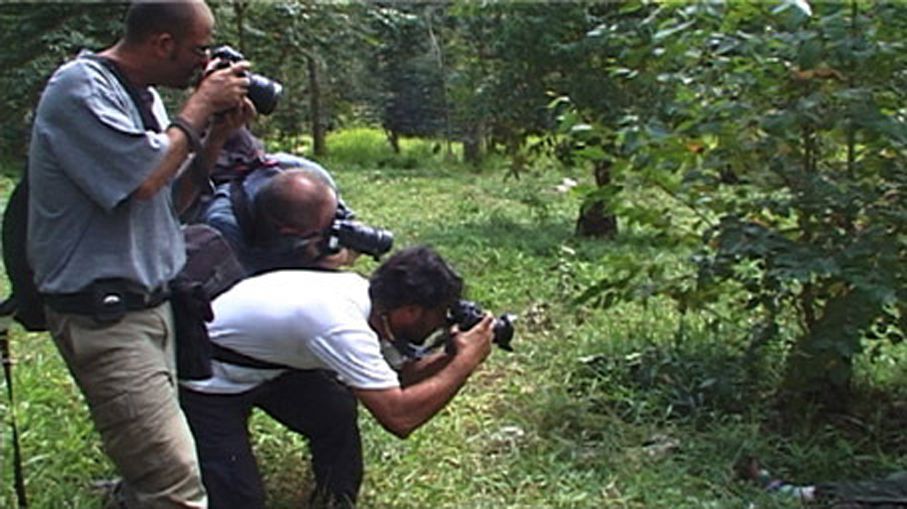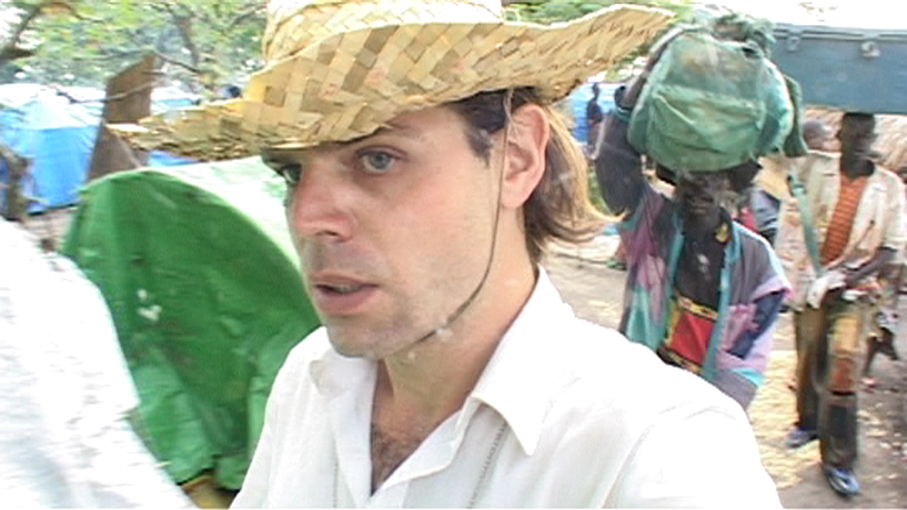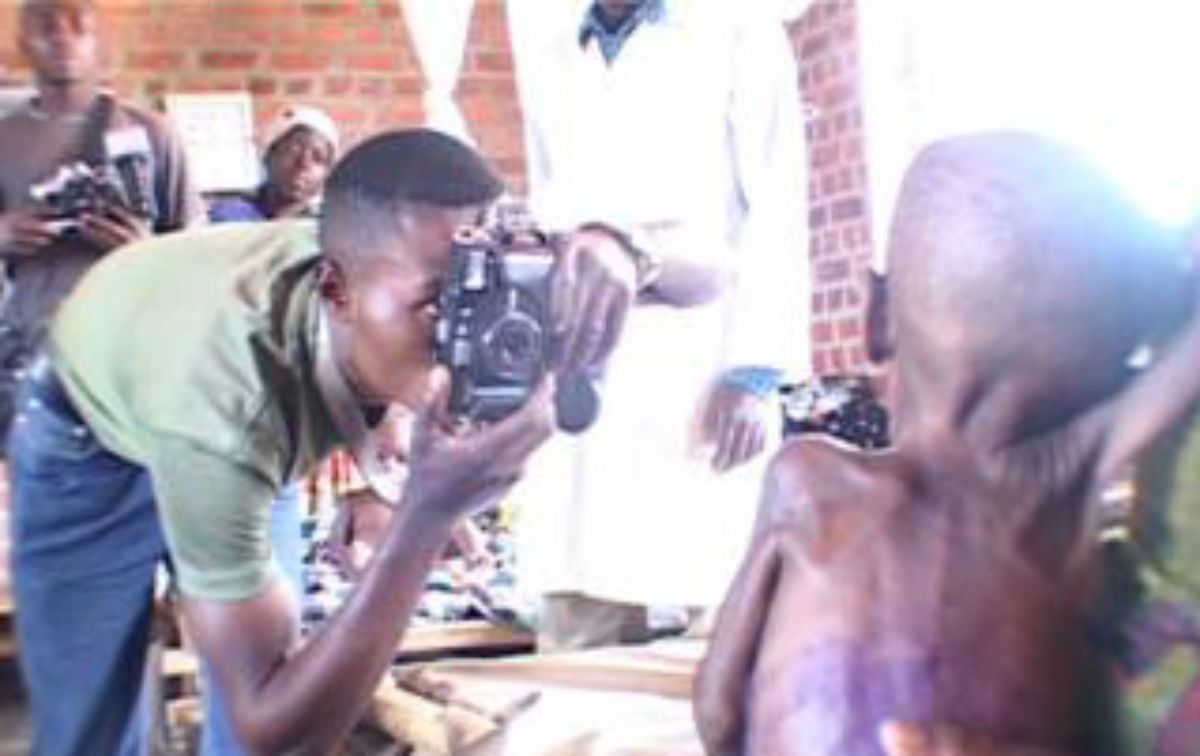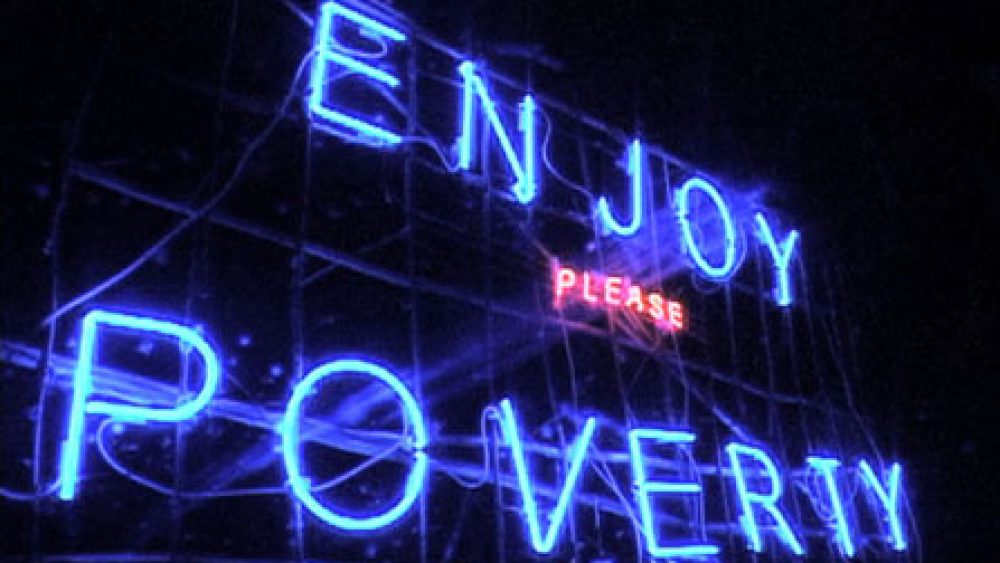Une bonne nouvelle
Notes on Renzo Martens’s Episode III - Enjoy Poverty
“... the truth, the “whole truth”, surpasses the facts and requires the rupture with their way of appearing.”
– Herbert Marcuse
“God whispers to us in our pleasures, speaks to us in our conscience, but shouts in our pains: it is His megaphone to rouse a deaf world.”
– C.S. Lewis

Awkward confidentiality
Documentaries about the world’s “problem zones” are always slanted towards an exclusively western public that needs “sensitizing.” They address us over the heads of the people imprisoned in the image. At the beginning of Episode 3 RM follows a path through the forest, accompanied by a number of African porters bearing heavy chests. In close up, he confides in us with an almost pathetic gravity. Not wanting his companions to overhear, he discloses in a near whisper: “You can't give them anything they don't already have. You shouldn't give them anything they don't already have. You should train them, empower them. There are new opportunities, new markets, new products. ... The people in the forest have no clue,” he closes pityingly. Only minutes before, he told several of the Africans he was far from impressed by their fishing catch, that perhaps it was time to fish for something else, where the word “fishing” has an awkwardly Christian undertone. Instantly, as though someone is disclosing an obscene secret you’d rather not hear, you are vaguely irritated at being made an unwitting accomplice. Against a background of sweating porters, RM’s talk of “new markets, new products” and the like seems inappropriate and pedantic at best: “Ah, if only they’d open their eyes!” In fact, the scene of our inadvertent complicity is invisible. It is that of the white man who has the privilege of informing his equals in the living room, cinema or museum, of the situation in which the locals are so immersed they cannot see the wood for the trees. The voice in which RM rather conspiratorially addresses us and himself, addresses himself through us, reveals the gulf yawning between himself and the bearers with whom he navigates the trail. His confidential tone suggests that half a word is sufficient for us to grasp his point. There is something intolerable in the self-evidentiary nature of this understanding, even if this understanding is the tacit condition for every documentary or report. That the film-maker talks to his civilised equals over the heads of those whose lives he is documenting, is masked in every film or TV report by an objectivist discourse offering supposedly neutral information on circumstances in situ. We all take for granted the serene, detached tone of the voice off, interview or commentary adopted by reporter the world over. RM does not pretend to identify “more deeply” or “intensely” with the situation. Quite the contrary: the way in which he films himself reveals the extent to which he is a Fremdkörper in the world he is investigating. In which he is unrelenting. When an African asks him whether the word POVERTY on the panel he is setting up is incorrectly spelled, RM casually explains that this panel is intended for an international audience which overwhelmingly opts for English: “Le film sera montré en Europe, pas ici!” Images documenting suffering are not, of course, for the suffering; they are for those who, thousands of kilometres away in the globalised evermore Anglo Saxonised culture, have the luxury of being able to pity and, thus, to comment on suffering, to explore it, to place it within a broad social, economic, political, psychological, theological global context...
The smile as logo
In a refugee camp in East Congo, healthy, well-nourished boys and girls in white T-shirts are taking photograph after photograph of black refugees sitting on the ground or under tents emblazoned with the UN logo. Their incessant smiles betray a formidable fear: a serious expression might reflect the distress of those they are photographing and, what’s more, suggest a pity they are ashamed of because they cannot validate it. [They, with their snap-happy equipment and sweetly smiling faces, are our people.] Their faces, equipped with cameras and smile, are ours. This faces are the humanitarian mask we assume when faced with the Africans who have drifted into the camp; the immaculate logo we use to shield us from what we cannot avoid seeing. The well-intentioned young people hide behind their starched smiles ánd apologise for hiding, for the unreal, empty, whiteness of their presence, for having come to take stock of the damage, not repair it. With their smile, they implore those they photograph to forgive them for not being Christ. They take photos as often as they blink, to avoid seeing what they are seeing, as if the camera is a UN-operated prosthesis. This prosthetic piece of equipment erases their own gaze, surrendering it to the Eye of the world. Whenever the shutter clicks, they are blind; it is left to the World to see. They infuse the World with the pity they deem obscene in themselves.

God and Mankind
Reflecting on the ocean of suffering that surrounds us, many invoke God, even if not admitting to it, because they don’t believe in God. Aware that pity is repugnant because it is the cheapest way of feeling like a ‘good’ person, we are quick to appeal to a God, not a God that would end suffering because that is too naive, but a God that will appropriate our pity in order to cleanse it, a God who pities with integrity and detachment like the God of Saint Augustine, whose pity is so pure because it is “without sorrow” – because sorrow is an emotion and every emotion all too easily becomes intoxicating. According to the haggard individual known as the “last pope” in Nietzsche’s Zarathustra, God died of his pity for mankind. When young and energetic, God was intractable and vengeful. But as the years passed, his pity for his creations grew, becoming overwhelming; God finally succumbed to his pity. God’s inglorious demise is, of course, a human matter. Another wretch Zarathustra encounters, the “ugliest man” tells us more: he killed God and calls his murder “revenge on the witness”. The eye of God, which followed him in his wretchedness, became unbearable: “But he – had to die: he looked with eyes which beheld everything, – he beheld men's depths and dregs, all his hidden ignominy and ugliness. His pity knew no modesty: he crept into my dirtiest corners. This most prying, over-intrusive, over-pitiful one had to die. He ever beheld me: on such a witness I would have revenge – or not live myself. The God who beheld everything, and also man: that God had to die! Man cannot endure it that such a witness should live.”
But eliminating this witness was no solution. God’s murderer now had to endure the burden of God’s pity. Hence his ugliness. Now he himself became the witness, of himself and others, preferably others, because no one wants to be the object of pity. It is humiliating to be reduced to a needy creature: unable to derive any strength or wisdom from its suffering, it’s greatest desire is to suffer no longer. To no longer be complicit in this impossible, humiliating pity we inherited from God we, ugly people, devised another logo: Humanity, the Civilised World that detects suffering in the world and offers relief where it can. Humanity as a sort of Lens through which we see the sufferings of the world. When we look through the Lens this dead God, who could not endure his pitying, haunts us. ‘“Suffering humanity” is something we know through the God that died inside us. No longer with a God to pity in our stead, this suffering haunts us more than ever. This God was simultaneously distant and close, impersonal and intimate, detached and boundlessly loving. But in this modern logo, “Humanity,” this mysterious unity has divided itself. “Humanity” is as flawless, polished and unsullied as a computer screen, but we know this screen conceals an unsleeping Eye, amorphous, inflamed, burning, afire, pierced, terminally sick with its divine all-seeingness. The screen allows us to see without us having to see anything, but the Eye makes it impossible for us not to see, even though we are not looking. The Eye is too obscene to be liveable. So always wears dark glasses like a sun-bronzed adventurer, a slick businessman, a seasoned Doctor Without Borders or a poet who, melancholically besotted by his own impotence, fancies himself Rimbaud.

The girl, the logo and God
RM does not profess to challenge the logic of the logo. Quite the reverse: he forces that logic into a corner where it becomes obvious that the logo is no neutral “purely pragmatic” identifying mark: the logo is the medium with which the world is presented to us, only then becoming World. We know and feel through the logo. Together, We are We because of the logo. In the hut of a poverty-stricken man for whom RM has prepared a pan of fresh meat and vegetables, logos seem remote but, because this is an illusion, because there is no greater ideological deception than to think that this is just two men of flesh and blood sharing a companionable meal, RM produces a scrap of cloth bearing the flag of the European Union, and pins it to the dress of the man’s visibly malnourished daughter. RM doesn’t answer when the father asks what the point is. No one asks about the point of a logo: a logo is simply something in circulation. Its ways are unfathomable and, before you know it, there’s one pinned to your chest. The EU logo marks the infinite distance between two men that cannot be bridged by a human gesture. A distance RM again underlines when explaining to the man that he should not expect his circumstances to improve; he should not expect anything more than this meal that unexpectedly fell from the sky like a UN food parcel. RM shows no humanity; he is the cool ambassador of Pitying Humanity Ltd. After RM pins the logo to the child, the man gushes with gratitude: “Dieu existe,” he says, “je n'ai pas cru que je mangerais de la sorte avec mes enfants.” The only explanation he can conceive for the unexpectedness, the absurdity of RM’s gift, is “God.”
Nous sommes une source
An exhibition of evocative black and white photographs of plantation workers. The images tastefully exploit the romantic fascination for this kind of “unrestrained primitivism.” One can imagine a commentary suggesting that this series “dignifies the black workers.” The French owner and operator of the plantation buys several photographs. He is grateful to the photographer for transforming the bodies who labour for him in return for half a dollar every three days, into an emblem of Authenticity. Even a black visitor to the exhibition, familiar with the hopeless situation of the workers portrayed from personal experience, admits the photographs are a feast for the eye. Now, he experiences the poverty from which he escaped as quaint, even moving.
Un service émotionnel
RM's message: given that the Congolese are systematically denied the right to exploit and market their own raw materials themselves, the only primary capital resource available to them is in fact their own suffering. Up to now, this pain has been nothing more than a blind fate that they endure. Which is why, according to RM, the time is ripe for them to exploit this suffering – which involves them taking charge of the registration, distribution, and sale of the images of that suffering. For them, this is not only far more lucrative than dead-end labour in mines or on plantations: it is also a way of giving something back to Humanity. For poverty, as RM concedes to the Congolese en passant, is not merely a curse but “a gift given for the better understanding of life;” so it is worthwhile to give this gift to the World. Subsequently, the blacks are no longer simply beggars, but proud bearers of a gift that renders an “emotional service” to those privileged enough to belong to the World. And this is what, in simple terms, RM shares with the Africans in awe of his panel of neon letters “ENJOY please POVERTY”: “the experience of your suffering makes me a better person. You’re really doing me a favour, merci beaucoup.”

See their joy!
Is RM’s “message,” his “analysis of the situation,” accurate? Is the only way forward for the bitterly poor Congolese to take charge of representations of their own suffering so that they can sell their very lack of resources? However, the film soon makes clear that even this is a hopeless prospect. Urged on by RM, the local photographers can take as many photos of corpses, starving children and raped women as they like; but it won’t give them access to the image market. It is suggested that their project is morally inappropriate and unprofessional to boot. There may be channels to produce the work, but not to distribute it. The depiction of African suffering continues to be monopolised by western journalists, photographers and artists. It is clear that RM’s radically pessimistic analysis does not merit empirical testing: what it does is show in no uncertain terms that the rhetoric of hope paraded by countless reporters, professional photographers, UN officials, humanitarian workers, doctors and relief workers, is highly questionable. All justify their position based on the notion that “despite everything” there is still hope. Perhaps, in the light of the millions that perished in the wake of war or hunger during the last decennium in Congo, and of the many still living under threat of war and terror and in unmentionable wretchedness with the prospect of a premature, squalid, death – perhaps in this light it is immoral to suggest that there is always hope. There is no hope for the dead and even less for those to whom survival as a biological entity is the best they can expect from life. The rhetoric of hope not only glides too quickly over the dead, it also skims over the here-and-now of fatal misery. This is why hope is often simply a logo to make our pitying view of hopelessness endurable, purging it of all traces of obscene fascination for the life that survives, thereby reassuring us of our humanity. Is RM being “ironic” when he encourages the Africans to throw a party in celebration of ENJOY please POVERTY? He replaces the obligatory, humanitarian logo of hope by that of assumed hopelessness: of acceptance. While the Africans are surrounded by logos making vague promises to redeem them from their misery, their poverty itself now becomes a logo. A logo they do not reject. As the tom-toms sound, RM entreats some of the men to resign themselves to their fate; advice which they accept. The neon words, resonant with the Christian message that poverty is a blessing for it brings man closer to God, lights up in the night. It is written in a language alien to the partygoers, its presence an echo of the global culture of spectacle, its roots in the local community non-existent. An emblem of their displacement and, precisely because of this, the logo evokes a desire for something completely new: for the coming of something or someone that can change everything with a single blow; in a flash. It is a preposterous, scandalous coincidentia oppositorum: the very words that exhort them to resignation kindle a glimmer of light in the darkness that is their lives. The words that implore them to abandon all hope are also the emblem of a messianic hope, a hope that gives them nothing to hope for, thus does not frustratingly, humiliatingly entice with a dream against which they measure their quality of life. “Non, il n'y a rien préparé pour vous!” RM exclaims. Apart from this absurd message hanging in thin air, he has nothing more to offer. Normally, logos – however omniscient – are cloaked by the sober pragmatism of humanitarian action. Now, all that is visible is the logo, glimmering over a knot of shadowy figures gazing at it in awe. “The children love it,” says one man, “c'est un bonne nouvelle.” And when, brimming with delight, he adds: “voie leur joie!” it is almost unendurable, because there is nothing more moving than the joy of children without a future; you rein in such an emotion because it is tainted by the familiar “Well, they’re so grateful, you know! Satisfied with so little!”

Is he not inhuman?
RM’s films prompt one to ask about the man behind the artist. We want to be assured his intentions are good; that, all in all, he means the world well. This is our way of exonerating ourselves beforehand, fearful that, at the unprotected mercy of our own eyes, we will be complicit in something we suspect is inhuman. This is, of course, a defence mechanism: we are already complicit but refuse to acknowledge it, and thus project everything onto the filmmaker. “Isn’t what he does plain cynical?” “His cynicism’s just a cover – he’s super-sensitive!” With speculations of this sort we evade responsibility for dealing with the dilemmas and impasses that RM draws us into.
There’s a shadow hanging over me
What does RM want? What is he driving at? What is his hidden agenda? What is he if he isn’t a relief worker or photographer and only appears to be a journalist? The whiteness of the photographers, their faceless, dead smiles, is nothing strange to him. When interviewing a plantation owner or men working for a gold-mining company RM seems an investigative journalist, but not when trying to convince people their poverty can be a source of income, or when telling them accepting their poverty will bring peace of mind. And, when asked by a 'human rights investigator' what he is doing in Congo, he earnestly replies: “I teach them how to deal with life,” his response smacks of pedantry, paternalism, quackery or plain idiocy; the irony we strain to hear is absent, although our desire of that irony is equally idiotic. Hypothesis: RM is “RM”. He is a logo, a wandering logo like his ENJOY please POVERTY sailing down the river. While today businesses and organisations want to be seen and recognised the world over, want to be “branded” into our minds, to tattoo the skin of the world with their logo, they are meanwhile becoming evermore shadowy and obscure when it comes to location, management and financing. RM embodies this abstraction of the logo that, ubiquitously, represents something that is equivocal and unapproachable. Which accounts for the anomalous melding in RM of narcissism and detachment, self-promotion and absence, as if focusing attention on himself is simply a way to expose a kind of lack, an insufficiency. The film contains a Tarkovsky-esque scene. RM walks through a forest where the earth underfoot is marshy. His black companions proceed ahead, carrying heavy cases. His expression is grave and slightly pained. Under his breath he sings: “A man needs a maid.” While, half-blinded by the sun, he turns his face to the sky, the violins surge and Neil Young’s world-famous querulous voice breaks out. The camera pans to RM’s bearers and, finally, to the swollen river that, having burst its banks, shimmers in the sun. This is the one and only time the film pauses on a scene devoid of people and nature, as it were, immediately utilises this to unabashedly reveal its purposeless splendour. Just for a moment, in this sophisticated, painfully composed scene at odds with the rest of the film, RM is an actor supported by Young’s opulent, plangent love song, vanquishing the audience with a single sehnsuchtige glance. But the sublime kitsch of this scene does nothing to conceal the fact that this actor is only playing himself: the actor that he is. His Sehnsucht is a logo, an indelible identifying mark he wears on his face. In the guise of the melancholy artist in love with his impotent quest for redemption, RM is himself. “It was cold, and it rained, and I felt like an actor.”
This text was originally published in SMBA (Amsterdam: November 2008).
With thanks to Frank Vande Veire

